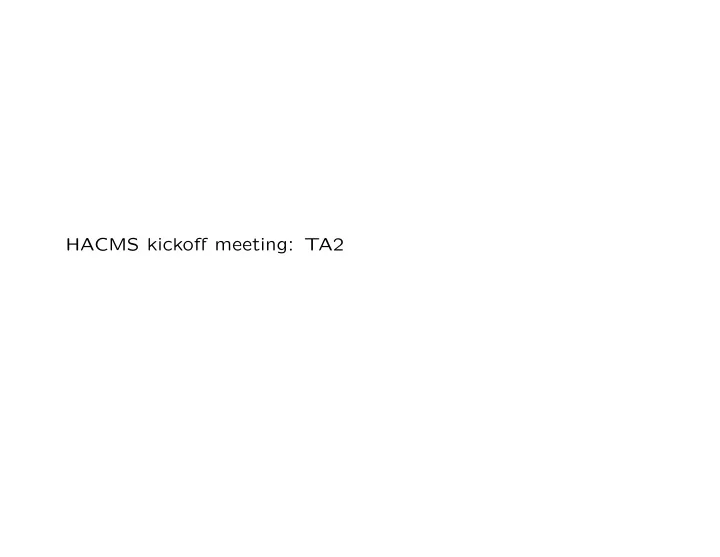

HACMS kickoff meeting: TA2
Technical Area 2: System Software John Rushby Computer Science Laboratory SRI International Menlo Park, CA John Rushby, SR I System Software 1
Introduction • We are teamed with Prof. Grigore Rosu of University of Illinois at Urbana Champaign on this task • I’ll describe our part • Then hand over to Grigore John Rushby, SR I System Software 2
Background • All incidents and accidents in commercial aircraft in which software was a contributory factor implicate the gap between system requirements and software requirements • None implicate design or coding errors • Level A software for commercial aircraft costs a lot • Vulnerabilities in other kinds of vehicles may be different • FM may reduce costs for aircraft and raise quality elsewehere • But the gap may still be there • That’s what we (SRI) are focused on John Rushby, SR I System Software 3
A Conundrum • Top-level safety requirements are probabilistic (e.g., 10 − 9 ) • But software assurance is all about correctness • JUst do more of it for higher assurance levels ◦ 28 objectives at DO178B Level D ( 10 − 3 ) ◦ 57 objectives at DO178B Level C ( 10 − 5 ) ◦ 65 objectives at DO178B Level B ( 10 − 7 ) ◦ 66 objectives at DO178B Level A ( 10 − 9 ) • What’s the connection? John Rushby, SR I System Software 4
A Simple Theorem • Software assurance establishes a possibility of perfection ◦ Will never suffer a failure, wrt. system requirements • Quantify that as (subjective) probability of (im)perfection ◦ An idea due to Bev Littlewood and Lorenzo Strigini • p np probability the software is imperfect • p fnp probability that it fails, if it is imperfect • Then P ( software fails ) ≤ p np × p fnp • Traditionally, nuclear protection assumes p np is 1, measures p fnp by massive random testing • And aircraft certification assumes p fnp is 1, try to justify small p np by massive assurance John Rushby, SR I System Software 5
A Second Theorem • Many safety-critical systems have two (or more) diverse “channels” arranged as primary/monitor architectures • Cannot simply multiply the pfds (probabilities of failure) of the two channels to get pfd for the system ◦ Failures are unlikely to be independent ◦ E.g., failure of one channel suggests this is a difficult case, so failure of the other is more likely ◦ Infeasible to measure amount of dependence • But the probability of imperfection of one channel is conditionally independent of the pfd of the other • So you can multiply these together to get system pfd John Rushby, SR I System Software 6
Putting It Together • Formally synthesize or verify monitors for system requirements • Monitors can be simple, as well as formally assured • Thus, feasible to claim small probability of imperfection • Hence, multiplicative increase in system reliability • Though you do need to account for Type 2 monitor failures • Monitored architecture risk per unit time ≤ c 1 × ( M 1 + F A × P B 1 ) + c 2 × ( M 2 + F B 2 | np × P B 2 ) where the M s are due to mechanism shared between channels John Rushby, SR I System Software 7
Mechanization • Biggest breakthrough in FM over last 20 years was development of high-performance SMT solvers • These solve Forall (UNSAT) and Exists (SAT) problems • They automate verification problems very effectively • But for synthesis need to solve Exists-Forall (EF) problems • Example: template based invariant synthesis ◦ ∃ A, B, C : ∀ x, y : A × x + B × y < C ◦ Many template- or sketch-driven approaches to synthesis can be cast in this form • So we plan to synthesize monitors with an EF-SMT solver John Rushby, SR I System Software 8
EF SMT Solver Architecture John Rushby, SR I System Software 9
Plan • Develop EF-SMT solver ◦ Bruno Dutertre • Use to synthesize monitors and wrappers for systems software • Share languages, methods, tools with Grigore Rosu of UIUC ◦ Who develops complementary approaches to monitoring John Rushby, SR I System Software 10
Recommend
More recommend